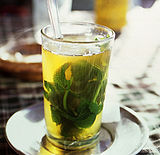- Moroccan tea culture
-
Moroccan tea culture (Arabic: الشاي - as-shāy , Moroccan Arabic: اتاي - Ataí) is defined by the way tea (exclusively green tea) is prepared and consumed in Morocco, where it is widely consumed with food. The tradition has also spread throughout North Africa, parts of the Sahel, and southern Spain. Tea occupies a very important place in Moroccan culture and is considered an art form. Morocco is one of the biggest tea importers of the world.
Moroccan mint tea is a green tea with mint leaves.
Moroccan-style mint tea is now commonly served all through the West Arab World (North Africa). It is served not only at mealtimes but all through the day, and it is especially a drink of hospitality, commonly served whenever there are guests. Unlike Moroccan food, cooked by women, this tea is traditionally a man's affair: prepared by the head of the family. It is served to guests, and it is impolite to refuse it.
Morocco, Tunisia and Algeria, countries where it is most often drunk, consume respectively 1.4, 1.5 and 0.7 kg of tea yearly per capita.
Contents
Origins
It is believed that green tea was first introduced to Morocco in the 18th century, and began spreading through the country in the mid-19th century at the time the trade between the Maghreb and Europe started flourishing. It is reported that Sultan Moulay Ismail received many bags of tea and sugar as gifts and recompenses given by European envoys in order to release European prisoners.
The main provider of tea to Morocco remains China. According to the Moroccan trade ministry, Morocco imported more than $56 million worth of Chinese tea during the first half of 2006. Morocco is considered the first importer of Chinese green tea worldwide.[1]
Preparation
The method of preparation of atai is relatively complex and varies from region to region. It is normally sweeter in the north of Morocco than in the south, and in some places, pine nuts are added. In the winter, if mint is rare, sometimes leaves of wormwood (chiba or sheeba in Moroccan Arabic) are substituted for (or used to complement) the mint, giving the tea a distinctly bitter flavor. Lemon Verbena (louiza in Moroccan) is also used to give it a lemony flavor.
The typical green tea used is a gunpowder tea variety imported from China. A simple and practical method runs as follows:
- In a teapot, combine two teaspoons of tea-leaf with half a litre of boiling water. Allow it to steep for at least fifteen minutes.
- Without stirring, filter the mixture into a different stainless steel pot, so that the tea leaves and coarse powder are removed.
- Add sugar (about one teaspoon per decilitre).
- Bring to boil over a medium heat. This important step in the preparation process allows the sugar to undergo hydrolysis, giving the tea its distinctive taste.
- If desired, add fresh mint leaves to the teapot or directly to the cup. Remember to remove the mint within two minutes, as it can give some people acid reflux.
Nowadays many Moroccans choose to drink green tea without mint because of health concerns related to the large quantities of pesticides used in mint cultivation[citation needed].
Traditionally the tea is served three times, and the amount of time the tea has been steeping gives each of the three glasses of tea a unique flavor, described in this famous proverb:
Le premier verre est aussi amer que la vie,
le deuxième est aussi fort que l'amour,
le troisième est aussi doux que la mort.The first glass is as bitter as life,
the second glass is as strong as love,
the third glass is as gentle as death.See also
References
- Much of the content of this article comes from the equivalent Arabic-language Wikipedia article, accessed September 30 2006.
Tea Black tea Oolong tea - Bai Ji Guan
- Red Robe
- Darjeeling Oolong
- Dongding (Tung-ting)
- Dong Fang Mei Ren
- Huangjin Gui (Golden Osmanthus)
- Qilan tea
- Pouchong
- Rou Gui
- Shui Jin Gui
- Shui Hsien (Shui Xian)
- Tie Luohan
- Tieguanyin (Iron Goddess)
Green tea - Aracha
- Bancha
- Green Spiral
- Chun Mee
- Da Fang
- Genmaicha
- Liuan Leaf
- Gunpowder
- Gyokuro
- Hojicha
- Hou Kui
- Huang Shan Mao Feng
- Hyson
- Kabusecha
- Kamairicha
- Konacha
- Kukicha
- Longjing (Dragon Well)
- Matcha
- Mao Jian
- Mecha
- Meng Ding Gan Lu
- Sencha
- Shincha
- Tamaryokucha
White tea Yellow tea Post-fermented tea Blended and
flavoured teasTea culture Tea beverages Other - Camellia sinensis (tea plant)
- Tea bag
- Teapot
- Consumption
- Flowering tea
- Glass-holder
- Health effects
- Tea processing
- Samovar
- Tea brick
- Tea garden
- Tea house
- Tea tasting
- Teakettle
See also Categories:- Arab cuisine
- Tea culture by country
- Moroccan culture
- Moroccan cuisine
- Tea by country
Wikimedia Foundation. 2010.


